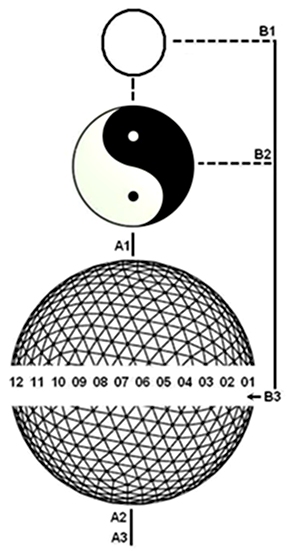|
| 'Tai Chi' Ruler Map |

|
| Principle Relations Graphed |
CHART Diagram Far Right:
>B1 靜 jing,
quiet, still, motionless; gentle
平靜 píngjìng, tranquil, undisturbed, serene
靜坐 jìngzuò,
to sit quietly, to meditate
靜心 jìngxīn, meditation, calm
靜恬 jìngtián,
quiet, peaceful (of a mind)
樹欲 靜而 風不 止 shùyù jìng'ér
fēngbù zhǐ
lit. the trees long for peace but the wind will never cease (idiom)
fig. the world changes, whether
you want it or not
風平浪靜 fēngpíng-làngjìng
lit. breeze is still, waves
are quiet (idiom);
tranquil environment, all is quiet, a dead calm (at sea)
>B2 靜動 jing dong, quiet, still, motionless,
gentle -motion
動 dong, to move
推動
tuīdòng, to push forward,, to promote, to actuate
轉動 zhuàndòng,
to rotate about an axis, to revolve. to turn, to move in a circle, to gyrate
運動 yùndòng
to move, to exercise, sports, exercise, motion, movement
靜坐不動 jìngzuò bùdòng,
to sit still and do nothing, to sit tight
>B3 柔則 róu zé,
supple-yielding imitate and follow
柔 róu, soft, flexible, supple, yielding
柔和
róuhé. gentel, soft
柔道 róudào, judo-sport
柔術 róushù, jujusu, contortion
則 zé, conjunction used to express contrast with a previous sentence
or clause, standard, norm, rule. to imitate, to follow, principle, classifier for written items
法則
fǎzé, law, rule, code
原則 yuánzé, principle, doctrine
守則
shǒuzé, rules, regulations
CHART Diagram Center:
>A0 no identity markers [Comment: this unidentified
circle would be representative of wu-chi leading to a bindary relation tai-chi; of before wu-chi.
>A1
十二 柔 shí'èr róu, 12- soft, gentle, pliant activities
http://www.mdbg.net/chindict/chindict.php?cdqchi=柔
>A2 八 則 bā zé, Eight
supple-yielding imitate-follow
八 bā , number eight, symbolic of eight
則 zé
conjunction used to express contrast with a previous sentence or clause,
standard, norm, rule. to imitate, to follow, then,
principle, classifier for written items
>A3 站樁法 zhàn zhuāng
fǎ, standing [as] post methods
站 zhàn, station, to stand, to halt, to stop.
branch of a company or organization
樁 zhuāng, stump, stake, pile, classifier for items
法
fǎ, law, method, way, Buddhist teaching
CHART Identities [Far right to left]:
1> 太極尺
tai chi chih, 'Tai chi' Ruler,
尺子 chih sz, ruler, rule
2> 平手 捕魚
Ping-shou mu-yu, Horizontal Fishing,
平手 píngshǒu. a draw, a tie [in sports]
捕魚
bǔyú, to catch a fish
3> 反手 捕魚, Fan-shou mu-yu,
Swirling Fishing
反手 fǎnshǒu, to turn a hand over. to put one's hand behind one's
back.
fig. easily done
反 fǎn contrary, in reverse, inside-out or upside-down, to reverse, to return,
to opposite
返 fǎn to return to
反擊 fǎnjī to strike
back, to beat back, to counterattack
反身 fǎnshēn, to turn around
反動
fǎndòng, reactionary-motion
摶 tuán to roll up into a ball with one's hands, spiral,
circle, variant of 團|团
旋 xuan, to loop, circle, revolve
挒 liè, Spiral,
split
4> 合拳 hé quán,
unified fist-boxing, unified-harmoious puglism
合 hé, to join, to fit together, to make equal,
合一 héyī, to unite as one
掌 zhǎng, chang, palm of the hand, palming
手掌
shǒuzhǎng, shou-chang, plam of hand, palm
合掌 hézhǎng, ho-chang, to clasp hand, to put
one's palms together
統 tǒng, dong, to gather,to unite, to unify, whole; govern,
command, control; unite a series, interconnected system.
5> 連還 進推 步 Lian-Huan Jin [Chin]
tui bu, serial Advance, withdrawal posture,
連 lián, to link, to join, to connect, continuously, in succession
還
huán to return, to pay back
進 jìn, to advance, to come into; 進行 jìnxíng, to advance,
in progress, to do
推 tuī push, expel, push forward
進退 jìntuì, to
advance or retreat, knowing when to come/ and to leave
步 bu, step, pace, stance
6> 木球 mu qiu [chiu],
Wood ball, Liu qiú, ball playing.
木 mù, wood, tree, wooden.
球 qiú, ball, sphere,
globe.
打球 dǎqiú, to play ball, to play with a ball.
7> 石球 shih qiu [chiu], Stone ball.
石
shí, rock, stone, stone inscription, one of the eight ancient musical instruments 八音.
球
qiú, a ball, shere, globe.
8> 手棍 shǒu
gùn, lu, Hand rod, pole
棍 gùn, stick, rod, bar, wand, bastinade,
stave.
棍子 gùnzi, stick, rod.
杆 gān, pole.
9>
吊棍 diào gùn, suspend-hang, stick-rod, pole
掛杆
tiao lu, hanging rod.
吊 diào, hang, suspend, lift up, revoke, hang a person, withdraw.
扳
bān, to pull, to draw out, to turn.
10> 靠板
kào bǎn [pan].
靠 kào, to lean against or on, to stand by the side of, to come near
to, to depend on, to trust.
板 bǎn board, plank, plate, shutter, table tennis bat.
11> 掤手 bīng shǒu Go up hands, to pull something,
upward hand 向上手 掤/崩 bīng,bēng, Up, ward off. 掤
bīng arrow quiver 'to pull on something'. 手 shǒu hand. 12>
按手 àn shǒu, Go down hands. 按手下去 downward hand 向下手 按
àn, Down, press down, to control, to restrain, to keep one's hand on to press, to push, to leave aside
or shelve, to control, to restrain, to keep one's hand on, to check or refer to, according to in the light of, to make a comment. 按摩
ànmó massage, to massage. 按捺 ànnà, to restain, to control. 手
shǒu, hand. Reference:
http://www.mdbg.net/chindict/chindict.php?page=worddict&wdrst=1&wdqb=石球+
References:
|

